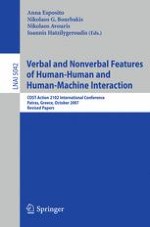This book is dedicated to the dreamers, their dreams, and their perseverance in research work. This volume brings together the selected and peer–reviewed contributions of the p- ticipants at the COST 2102 International Conference on Verbal and Nonverbal F- tures of Human–Human and Human–Machine Interaction, held in Patras, Greece, October 29–31, 2007, hosted by the 19th IEEE International Conference on Tools with Artificial Intelligence (ICTAI 2008). The conference was sponsored by COST (European Cooperation in the Field of Scientific and Technical Research, www.cost.esf.org ) in the domain of Information and Communication Technologies (ICT) for disseminating the advances of the - search activity developed within COST Action 2102: “Cross-Modal Analysis of V- bal and Nonverbal Communication”(www.cost2102.eu). COST Action 2102 is a network of about 60 European and 6 overseas laboratories whose aim is to develop “an advanced acoustical, perceptual and psychological analysis of verbal and non-verbal communication signals originating in spontaneous face-to-face interaction, in order to identify algorithms and automatic procedures capable of identifying the human emotional states. Particular care is devoted to the recognition of emotional states, gestures, speech and facial expressions, in antici- tion of the implementation of intelligent avatars and interactive dialogue systems that could be exploited to improve user access to future telecommunication services”(see COST 2102 Memorandum of Understanding (MoU) www.cost2102.eu).
